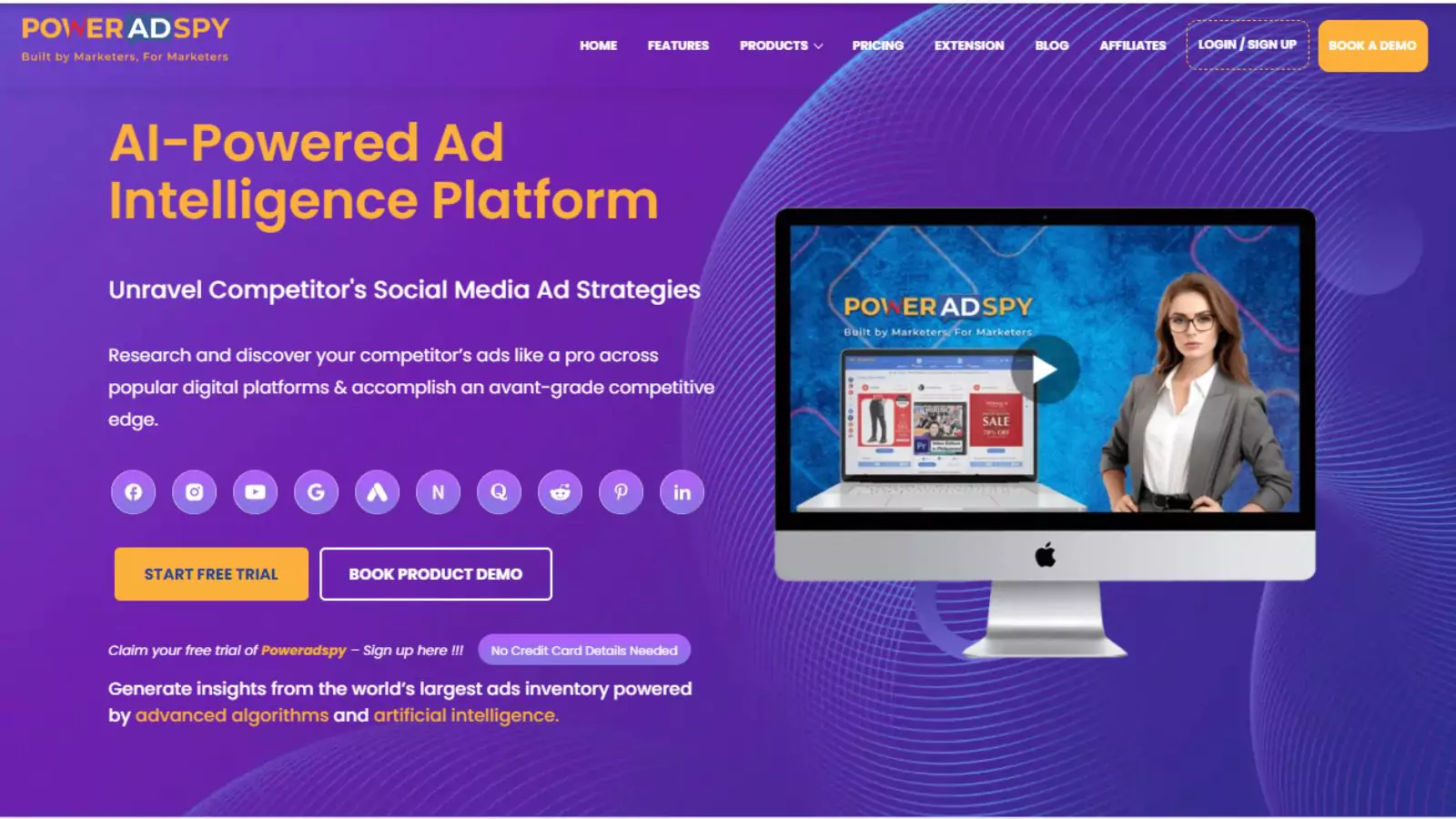The Ultimate Guide To Google Retargeting Ads
With the digital footprints users leave behind and the heaps of data collected, advertisers can segment their audiences and serve up personalized ads using Google retargeting ads that are way more likely to lead to conversions.
Different audience groups have varying levels of interest and familiarity with brands, so it’s vital to tailor your approach accordingly using the right tone, incentives, and offers for each group.
If someone is interested in your brand but hasn’t taken any action, there might be a chance that retargeting such an audience would help you gain more sales.
In that case, remarketing becomes an essential part of any brand’s marketing strategy.
When it comes to advertising on Google, there are countless options to create super-targeted campaigns for Google remarketing.
Let’s dive into how you can make the most of Google Display retargeting to boost your ROI and revenue.
Hit ‘Play’ Button & Tune Into The Blog!
What’s Google Remarketing?
Google remarketing, also known as Google retargeting ads, targets individuals already familiar with your brand but haven’t made a purchase yet, referred to as warm audiences. It operates within the marketing funnel, which guides customers through various stages before purchasing.
Remarketing targets those already interested, making conversion easier. The strategy involves displaying personalized ads to remind them of your brand and their previous interest. Additional incentives like discounts enhance the effectiveness of these reminders, increasing the likelihood of a sale.
But how to run Google retargeting ads campaign in Google ad networks. Let’s explore it and learn about it.
How To Set Up Google Retargeting Ad Campaigns
Google’s version of retargeting is called Dynamic Remarketing. These campaigns are super targeted, showing personalized ads to people based on what they’ve checked out on your website earlier. You need to create feeds for your products before all that cool stuff can happen. These feeds give the campaign the info it needs to show the appropriate ads to the right people.
To get those feeds to Google, you can do it manually or through your Google Merchant Center account, especially if you’re in retail. If you go with the Merchant Center option, you need to link your ad account to it. Also, you have to set up Google Tags on your website to track events like page visits.
Here’s how to create feeds and connect your Merchant Center account to your advertising account:
1. In Your Merchant Center Account, Head To The Feeds Section Under Products And Hit The Plus Button In The Main Feed Area.
Fill in the following details:
- Target countries: Where your products are getting sold.
- Language: The language in which your product data is presented.
- Feed label: A label to identify which products are in this feed.
- Destination: Choose the location where your feed is going to be used.
- Primary feed name: Give your primary feed a name.
- Input method: Choose how you’ll upload product data (like Google Sheets, scheduled fetch from your server, uploading files, website crawl).
- File name: Depending on your input method, name the file you’re submitting.
Click Continue, then you can manage your new feed in the Feeds section of your account.
2. Connect Your Merchant Center And Google Ads Accounts By Asking For A Link In The Merchant Center.
You can link more than one Merchant Center account to a Google Ads account, and vice versa. Here’s how to link your Merchant Center and Google Ads accounts:
- In your Merchant Center account, click on the gear icon and go to Settings, then Linked Accounts.
- Choose Google Ads and find the customer ID of the Google Ads account you want to link. You can see it at the top of any Google Ads page when you’re signed in, next to your email address.
- Click on the Link under “accounts” to complete the process.
How To Manually Input A Feed
- Make your feed a .csv, .tsv, .xls, or xlsx file.
- Upload it to the Business Data section of your Google Ads account.
- Select the wrench icon present at the top right corner.
- Under Setup, click Business Data.
- In the left menu, select Data Feeds.
- Click the plus button and pick Dynamic ad feed, then choose your business type.
- Select your feed’s file by clicking Choose File.
- Hit Apply.
Set Up A Dynamic Google Retargeting Ads Campaign
Here’s how to do it:
- Log in to your Google Ads account and go to the Campaigns section.
- Click on the plus sign and then select “New campaign.”
- Pick “Sales” as your campaign goal.
- Choose “Display” as your campaign type.
- Select “Standard display campaign” and click continue.
- Name your campaign, choose your location, bidding strategy, and budget.
- Go to “Additional settings,” and under “Dynamic ads,” select “Use a data feed for personalized ads.”
- Pick the business type of your feed from the drop-down menu.
- Click “Save and continue.”
- Choose “Remarketing lists” from the Select a category menu.
- Enter a bid for your ad group.
- Click “Save and continue.”
By following these steps, you can create effective Google retargeting ads.
You can also get assistance from a Google ads spy tool like PowerAdSpy to create highly effective ads that increase your brand recognition and boost sales and conversions.
These tools are highly effective in aiding you to craft the best-running ads by analyzing the most viewed ads of your competitors and learning the tactics used to improve their sales.
Let us understand how it works.
PowerAdSpy- Dominate Google Ads With The Best Ad Intelligence Tool
PowerAdSpy, an AI-driven ad intelligence tool, empowers you to analyze your competitors’ ads and unveil their strategies. With it, you can unearth successful ad creatives, audience-targeting tactics, and lucrative products within your market niche.
Some of the best features of this tool are:
Great Search Filters:
This tool helps you find ads by letting you pick specific things, like keywords, types of ads, and who they are for. It assists you to focus on what matters when checking out your competition.
Ad Performance Stats:
With PowerAdSpy, you get numbers that show how well ads are doing. You can see how many people are engaging with them. It helps you make better choices to make your Google dynamic search ads better.
Instant Updates:
You can keep up with what’s happening right now. PowerAdSpy is always updating its info, so you know what ads are out there at any moment. It helps you change your ad strategy quickly.
Harnessing insights from your competitors enables you to enhance your retargeting ads for superior performance. Beyond utilizing PowerAdSpy, here are some general tips for refining your Google retargeting ads:
Keyword Refinement:
Optimize your ad copy with relevant keywords to ensure alignment with user search queries.
Ad Content Optimization:
Keep your ad content updated and engaging, featuring high-quality visuals to captivate potential customers.
By leveraging PowerAdSpy and implementing these strategies, you can elevate your retargeting ad campaigns and maintain a competitive edge in the digital advertising landscape.
Having learned all about Google retargeting ads, it is vital to understand how it works.
So, let us begin.
How Does Remarketing Function Or Work?
People who check out your website are interested in what you have to offer. Google retargeting ads remind them about your products or services, reinforcing their interest. Understanding how remarketing operates is crucial for boosting your brand’s presence online through a tailored strategy.
Here’s how they operate:
It Allows You To Customize Incentives:
When you advertise your brand or products, you can target potential customers at any stage of their journey. For instance, if someone visits your site but doesn’t click on anything, you can catch their interest again by showing an ad about a service you offer. If a shopper adds something to their cart but doesn’t buy it, you could offer them a discount or free shipping to encourage them to complete the purchase.
Retargeting Is Cost Efficient:
Google retargeting ads are way cheaper than traditional paid ads to reach the same crowd. They’re super cost-effective for online advertisers. With remarketing, you target folks who’ve already checked you out, increasing the chances they’ll buy. This targeted approach stretches your ad budget further, giving you more value than old-school methods.
Bottom line: Google retargeting ads are a wallet-friendly way to reach your audience and boost sales.
Thus, these are the ways through which Google retargeting ads function. There are many advantages or benefits of retargeting through Google display ads. Let us delve into them.
Benefits Of Using Google For Remarketing
Google retargeting ads get ten times more clicks than regular display ads. So, it’s definitely a must-have tool for your advertising strategy.
Here are the benefits of using Google for remarketing:
Get A Broader Reach:
The Google Display Network covers over 2 million websites and reaches 90% of internet users, compared to only 27% on Facebook. This broader reach makes Google a better choice for remarketing because it allows you to connect with a much larger audience. With Google’s extensive network, your ads have a higher chance of being seen by potential customers, enhancing your campaign’s impact and effectiveness.
Easier To Customize:
Google Display Network lets you customize your remarketing ads more effectively. For example, if a shopper abandons a cart with baby clothes, you can target children’s apparel sites or parents with young kids. You can also customize based on:
- Devices
- Mobile apps
- Countries or specific areas
- Google search locations
- Languages
It allows you to target ads in many ways. For instance, if the baby clothes shopper is near your store, Google retargeting ads can show your ad when they check the weather app.
Targeting Individuals:
Remarketing ads are beneficial because they focus on specific products or services for people who showed interest in your site. If a customer added something to their cart or started filling out a form but did not finish, remarketing ads help you target them and try to bring them back.
High Conversion Rates:
The main goal of remarketing ads is to get the user to engage, whether it’s by making an inquiry or a purchase. Users who have visited your site before are more likely to take the next step compared to new visitors.
Lower Cost Per Clicks:
Remarketing campaigns often have a higher click-through rate than regular PPC campaigns. Since your audience already knows your service, they are more likely to click on your ad. A higher click-through rate increases your chances of conversions.
Choosing the Right Sites:
With remarketing ads, you can see how well each website hosts your ads by reviewing their click-through and conversion rates. If a site performs poorly, you can stop showing ads there and focus on sites with better results to improve your return on investment.
Track Ad Performance And Improve Customization With Google Analytics:
With Google Analytics, you can monitor the performance of your Google retargeting ads. You can allocate more budget to successful channels and cut back on underperforming ones. If your remarketing isn’t effective, Analytics helps you tweak your marketing strategy for improvement.
Moreover, Analytics enables deeper personalization of your remarketing campaigns. You can tailor your ads better by identifying common traits among ad responders. For example, if many young visitors leave your site without purchasing, you can target offers on websites popular among that age group, enhancing ad effectiveness.
Free Brand Recognition:
Remarketing has extra perks like boosting brand recall and recognition. When potential customers see your ad again, it reminds them of what they want to buy from you.
It makes them more likely to remember your brand when they think about their needs or wants. Plus, since you only pay when someone clicks on your ad, all that extra exposure comes at no additional cost to you.
Also Read:
Retargeting Ads: Effective Advertising
Google Dynamic Search Ads: Everything You Need To Know
Google Ads Campaign Optimization: Checklist & Actionable Tips
Google Ads Remarketing: Proven Strategies For Your Business
Steps To Designing A New Ad For Your Google Retargeting Campaign:
Creating new Google retargeting ads for your Google ad campaign includes setting up a remarketing tag, building your audience, creating the campaign, and designing the ad. Your ad will be more effective if it contains engaging text, high-quality images, and clear calls to action.
Here are the steps you can use to design brand-new Google retargeting ads:
1: Go to the campaign section in Google Ads and start a new campaign.
2: Choose the goal for your new campaign.
3: Pick your campaign type, such as Display Network.
4: Click Continue, then scroll to set your campaign budget on the next page.
5: Skip the rest, scroll to “Audiences,” and select your retargeting audience.
6: Design new ads for each list and segmented offer, then launch them.
7: Relax and watch as the conversions start to increase.
With these steps, you can easily create new ads for your Google retargeting campaigns and convert 98% of your website traffic.
Conclusion:
Google retargeting ads are a powerful tool to boost your marketing strategy by targeting users who have already shown interest in your brand. By setting up remarketing tags, building specific audiences, and designing tailored ads, you can increase your chances of converting these potential customers.
Leveraging the capabilities of Google Ads and an Google ad spy tool like PowerAdSpy empowers marketers to craft personalized, engaging campaigns that resonate with their target audience.
With the expansive reach of the Google Display Network and the cost-effectiveness of Google retargeting ads, businesses can maximize their advertising ROI while enhancing brand visibility and recognition. Through data-driven insights from Google Analytics, advertisers can continuously optimize their remarketing efforts, ensuring they deliver the right message to the right audience at the right time.
Thus, integrating Google retargeting ads into your marketing strategy can lead to heightened brand engagement, increased customer acquisition, and sustained revenue growth.
Google Retargeting Ads FAQs
Below are some common frequently asked questions about Google remarketing.
Is Google Retargeting Ads Free?
Cost consideration is crucial for marketers. Is Google marketing completely free? Not entirely. It’s a combination. Remarketing solutions are available if you’re running or considering running a Google ad campaign. However, the cost of Google retargeting ads varies depending on campaign features. Google Ads is cost-effective, offering reasonable rates per click, which benefits small business strategies.
Is Google Remarketing And Retargeting Different?
In Google Ads, “remarketing” and “retargeting” are commonly interchanged. While “Google remarketing” encompasses all aspects of Ads, “Google retargeting” typically denotes dynamic remarketing. Both terms are acceptable when discussing Ads and adding tags to ads, giving flexibility to online advertisers in describing their strategies.
What Are The Various Kinds Of Remarketing?
Regarding Google remarketing, there exist two strategies: standard remarketing and dynamic remarketing. Standard remarketing employs basic techniques, while dynamic remarketing is a more advanced, personalized approach. Dynamic remarketing enhances targeting and customization compared to standard remarketing, providing a more effective Google Ads remarketing method.











